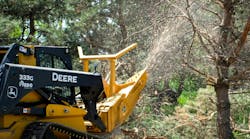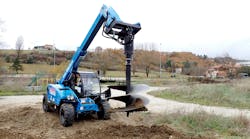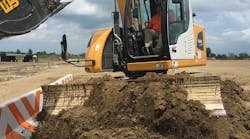Solidification/Stabilization (S/S) treatment is being used as a remedy component to treat contaminated soils and sediments at the Brunswick Wood Preserving Superfund Site in Brunswick, GA. This site was placed on Superfund's National Priorities List in 1997 and is currently undergoing remedial action under its Operable Unit One (OU1), which is addressing human health risk at this site.
Site HistoryThe Brunswick Wood Preserving (BWP) site is an 84-acre former wood-treating facility. The company treated wood from 1958 until 1991, when the site was abandoned. The three major types of wood preservatives prevalent at the time were used at the site: creosote, which consists of many polycyclic aromatic hydrocarbons (PAHs), pentachlorophenol (PCP, which is associated with dioxin), and chromium/copper/arsenate (CCA).
Wood-treating activities were historically conducted at many areas of the BWP site, including process areas, storage areas, the rail spur that ran along the southern end of the site, and several ponds or surface impoundments (IM). On its western end, the IM-1 pond was used during the 1960s and later buried, while the IM-2 pond is where creosote processing took place at the time operations ceased in 1991. On the site's eastern end, the IM-4 and IM-5 spray ponds were used for spent creosote. Wood preservative chemicals were released to surrounding soils and surface waters as a result of these operations.
After a fire in early 1991, the United States Environmental Protection Agency (EPA) responded to the BWP site and began a multifaceted four-year removal action. All but a few of the site structures were demolished and removed; sludges were dewatered; wastewater was treated; drums and lab wastes were disposed off-site; poles, lumber, equipment, and scrap metal were recycled or salvaged; and contaminated soils/sediments were excavated and stockpiled on site in four encapsulated waste cells, each covered by a geomembrane. EPA's removal costs were approximately $12 million. Subsequently, in 1997 and 1998, the state of Georgia conducted its own removal action at the BWP site, during which the three largest cells, primarily containing soils/sediments impacted by creosote and PCP, were disposed off-site. The state's removal costs were approximately $18.5 million.
The Selected RemedyThe selected remedy for OU1 at Brunswick Wood Preserving utilizes a containment strategy to encapsulate contaminants remaining on site. Remedy components include the construction of subsurface barrier walls around the old creosote ponds located on the eastern and western ends of the site, consisting of trenches that will be filled with a soil/bentonite mix and “keyed” into the weathered limestone aquitard located 50 to 65 feet beneath ground surface. Engineered caps will be placed over the barrier wall footprints.
Groundwater outside each of the cap/wall footprints will be treated in situ with chemical oxidation to enhance natural degradation of contaminants. The caps will include subcaps consisting of about 75,000 cubic yards of S/S materials from the creosote impoundments, Burnett Creek, site soils above the performance standard of 1 part per billion set for dioxin, and the remaining waste cell on site (which contains CCA-impacted soils). The S/S remedy component is being applied to these subcap materials.
S/S Treatment:S/S treatment involves mixing a binding agent, commonly portland cement, into contaminated soil, sediment, sludge, or waste. The treatment protects human health and the environment by immobilizing hazardous constituents within the treated material. Successful treatment is accomplished through physical changes to the treated material and often chemical changes to the hazardous constituents themselves.
The EPA has identified S/S treatment as the Best Demonstrated Available Technology (BDAT) for a variety of Resource Conservation and Recovery Act (RCRA)-listed hazardous wastes and has selected S/S treatment for 23 percent of its Superfund site source control remedies.
Innovative mixing techniques developed and applied at full-scale remediation projects in the U.S. have contributed to the versatility of the technology, and S/S treatment operations may be conducted either ex situ or in situ. During ex situ treatment, the waste material is first excavated, then mixed with the S/S binding agent, commonly with excavators or in pugmills. Ex situ treatment can be performed entirely on site by a mobile treatment plant transported to the site. During in situ treatment, cement is mixed into the contaminated material while it remains in place, commonly with excavators, horizontal rotary soil mixers, or deep soil mixing augers.
S/S treatment technology contributes to “green remediation” and the sustainable development of a contaminated property. While immobilizing hazardous constituents, the technology can also improve the construction properties of the treated materials, enabling its reuse. The technology can also alleviate the concerns of surrounding communities that are often associated with the off-site transportation and disposal of contaminated materials. Finally, the technology contributes to the conservation of landfill capacity, replacement fill, and fuel used in transportation with its associated air pollutants and greenhouse gases.
Treatment At BWPS/S treatment at the BWP site was applied to volumes of 11,000 cubic yards for surface soils above the dioxin standard of 1 ppb, pond sediments of 55,000 cubic yards, 8,000 cubic yards of materials from the remaining waste cell, and 600 cubic yards of Burnett Creek sediments, for a total volume of approximately 75,000 cubic yards.
These materials were excavated and staged for treatment. An excavator was used to pre-blend the staged material with a 10-percent addition by weight of fly ash. The pre-blended material was then run through a 2-inch screen to remove oversized material. After screening, the material was processed through a pugmill used to mix in portland cement. A 10-percent addition of cement by weight was used. Water was added to the material during pugmilling to result in a damp soil-like consistency. The treated material was loaded directly from the pugmill into off-road dump trucks, then it was transported to the former impoundment ponds for placement and spreading with a bulldozer.
The objectives for the S/S treatment were to reduce the mobility and toxicity of the contaminants of concern and to reuse the treated material on site as part of the capping system for the contaminated pond areas on the eastern and western ends of the site. The S/S treatment reduced the permeability of the material for use in the cap while improving its structural properties, which will contribute to the long-term protectiveness of the remedy and facilitate possible future site re-development.
Performance standards for the S/S treatment included unconfined compressive strength (UCS) of at least 100 psi (0.70 MPa) at 28 days, hydraulic conductivities of less than 1X10-6 cm/sec by falling-head permeability test, and no significantly increased leaching of contaminants of concern by Synthetic Precipitation Leaching Procedure (SPLP). Quality control tests include UCS tests on every 500 cubic yards treated and permeability and leachability tests on every 1000 cubic yards treated. Full-scale mixing began after an initial pilot scale session lasting several weeks, which verified the achievement of performance standards using the mix design.
Re-Use Of S/S-Treated Material In Capping SystemThe remedy includes the construction of caps over the former creosote impoundments (IMs) on the eastern and western ends of the site. The caps will extend significantly beyond the pond footprints of these former ponds. The footprints were established by an informal groundwater standard of 1,000 ug/L of total semi-volatile organic compounds (SVOCs) to capture groundwater contamination within the barrier walls.
The capping system consists of subcaps, geosynthetic clay liners and a 2.5-foot-thick vegetative soil layer. S/S-treated material was used as the construction material for the subcaps. Freshly mixed S/S-treated material was discharged from the pugmill into dump trucks and then transported to the former impoundment areas, where the material was dumped and then spread/compacted by bulldozer. Successive layers of the material were placed to form subcaps at least 3 feet thick over the pond footprints themselves. A geosynthetic clay liner will be installed on top of the subcaps, and a 2.5-foot soil layer will be placed on top of the geosynthetic clay liner as a vegetative soil cover.
The use of S/S treatment technology in the remedy contributes to the future redevelopment options of the property. The strength of the capped areas resulting from the cement-treated subcaps will support the replacement of a former rail spur across the western wall/cap, while the eastern wall/cap will accommodate a potential concrete parking area. On-site management of the 75,000 cubic yards of S/S-treated material avoided nearly 4,200 dump truck roundtrips for transport of the material for off-site disposal and replacement fill.
| Author Information |
| Brian G. Farrier is remedial project manager, U.S. Environmental Protection Agency, Region 4. Edward C. Hicks, P.E., is project manager, Black & Veatch Special Projects Corporation. Charles M. Wilk is program manager, Waste Management, Portland Cement Association. |




